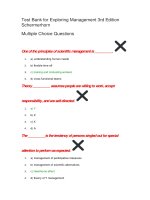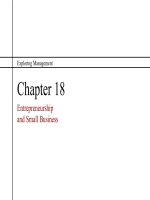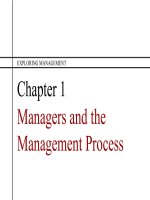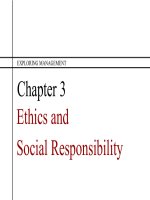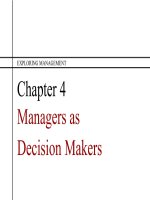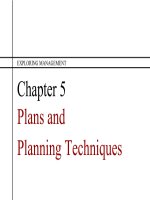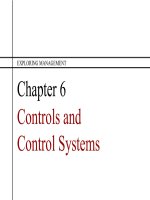Exploring management 3rd ch11
Bạn đang xem bản rút gọn của tài liệu. Xem và tải ngay bản đầy đủ của tài liệu tại đây (1.06 MB, 25 trang )
Exploring Management
Chapter 11
Leadership
Chapter 11
•
•
•
Understand the foundations for effective leadership.
Identify insights of the contingency leadership theories.
Discuss current issues and directions in leadership development.
11.1
Foundations of Leadership
•
•
•
•
•
•
Leadership is one of the four functions of management
Leaders use position power to achieve influence
Leaders use personal power to achieve influence
Leaders bring vision to leadership situations
Leaders display different traits in the quest for leadership effectiveness
Leaders display different styles in the quest for leadership effectiveness
FOUNDATIONS OF LEADERSHIP
The Leadership Function
•
Leading builds commitments and enthusiasm and turns plans into action
FOUNDATIONS OF LEADERSHIP
Power
•
Power is the ability to get others to do what needs to be done
Position Power
Personal Power
Management Power
FOUNDATIONS OF LEADERSHIP
Power
•
Position power –what an individual can do based on position in the
organization
– Reward power
•
“you can have this if you do this”
•
“do this or I’ll take this away”
•
“do it because I’m your boss”
– Coercive power
– Legitimate power
FOUNDATIONS OF LEADERSHIP
Power
•
Personal Power – how the leader is perceived as a person
– Expert power
•
Special skill or knowledge that influences behavior
– Referent power
•
Admirable and likeable qualities that influence behavior
FOUNDATIONS OF LEADERSHIP
Vision
•
•
Vision is a clear sense of the future
Visionary leadership is the ability to communicate the vision and how to
accomplish the vision
FOUNDATIONS OF LEADERSHIP
Leadership Traits
•
People want leaders who are
– Honest
– Competent
– Forward-looking
– Inspiring
– Credible
FOUNDATIONS OF LEADERSHIP
Leadership Styles
•
Leadership styles are a pattern of behavior
– Autocratic
•
Acts in a “command and control” fashion
•
Emphasizes people over tasks
– Human relations
–
Democratic
•
Participative with a strong emphasis on people and task
•
Little concern for people or tasks
– Laissez-faire
FOUNDATIONS OF LEADERSHIP
Leadership Styles
11.2
Contingency Leadership Theories
•
•
Fiedler’s contingency model matches leadership styles with situational differences
The Hersey-Blanchard situational leadership model matches leadership styles with the maturity of
followers
•
•
•
House’s path-goal theory matches leadership styles with task and follower characteristics
Leader-member exchange theory describes how leaders treat in-group and out-group followers
The Vroom-Jago model describes a leader’s choice of alternative decision-making methods
CONTINGENCY THEORIES
Contingency Leadership
•
Contingency leadership
– Successful leadership varies by the circumstances, task, leader and followers
CONTINGENCY THEORIES
Contingency Leadership
•
Fiedler’s contingency model
– Leadership style depends on the situation
– Least Preferred Co-worker Scale (LPC)
CONTINGENCY THEORIES
Hersey-Blanchard
•
Hersey-Blanchard situational model matches leadership style with
maturity of followers
CONTINGENCY THEORIES
Path-Goal Theory
•
House’s Path-Goal theory
– Help followers move along paths to achieve work and personal goals
– Four leadership styles
Directive leader
Supportive leader
Achievement oriented leader
Participative leader
CONTINGENCY THEORIES
Leader-Member Exchange
•
Leader-member exchange (LMX)
– In-groups
– Out-groups
CONTINGENCY THEORIES
Vroom-Jago
– Vroom-Jago model describes decision-making methods
Authority decision
Consultative decision
is made by the leader and
communicated to the group
Group decision
is made by a leader after
receiving input from the
group
is made by the group
themselves
11.3
Current Issues in Leadership
•
•
•
•
•
Transformational leadership inspires enthusiasm and extraordinary performance
Emotionally intelligent leadership handles emotions and relationships well
Interactive leadership emphasizes communication, listening and participation
Moral leadership builds trust from a foundation of personal integrity
Servant leadership is follower centered and empowering
CURRENT ISSUES
Transformational Leadership
•
Charismatic leadership
– Inspires others, creates enthusiasm and leads to extraordinary performance
CURRENT ISSUES
Transformational Leadership
•
Transactional leadership
– Directs through tasks, rewards, and structures
CURRENT ISSUES
Emotional Intelligence
•
Emotional Intelligence (EI)
– Ability to manage emotions in relationships
CURRENT ISSUES
Interactive Leadership
•
Interactive Leadership
– Emphasizes communication, listening and participation
– Gender similarities
•
Men and women are similar
in terms of psychological properties
CURRENT ISSUES
Moral Leadership
•
Moral leadership
– Builds trust through integrity
•
Ethical leadership
– Leaders with high ethical standards build ethical cultures
•
Integrity
– Honest, credible and consistent behavior that puts values into action and earns
trust
CURRENT ISSUES
Servant Leadership
•
Servant leadership
– Commitment to others
– Other-centered rather than self-centered
•
Empowerment
– Give others freedom to gain power, make decisions and achievement influence
